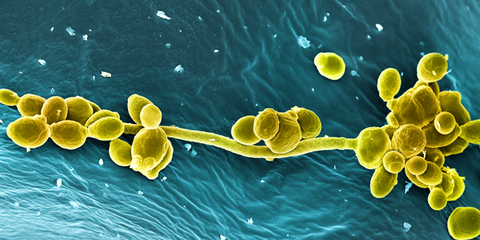How to Get Rid of Male Yeast Infection

microscope visuals unlimited inc./Getty Images
Between the itching, burning, and discharge, a yeast infection can be a total pain in the...well, vagina. But did you know they're not just a down-there problem? According to the Centers for Disease Control and Prevention, there are more than 20 different species of candida yeasts on and in your body (like, right now) that can cause a yeast infection—and not necessarily below the belt. Want to protect yourself? Here are 7 more icky factoids you should know:
1. They're not the most common vaginal infection
That honor goes to bacterial vaginosis (BV), an infection that's caused by an overgrowth of bacteria in the vagina. Much like a yeast infection, BV festers when the vagina's pH levels are out-of-whack—but unfortunately, OTC treatments aren't available. Because it's caused by bacteria and not yeast, attempting to use yeast infection meds to combat BV can make your symptoms worse (cue the sad trombone). If you self-treat thinking it's a yeast infection but your symptoms stick around, check in with your gyno to find out what's what, says Antonio Pizarro, MD, a board-certified gynecologist in Shreveport, Louisiana.
2. You can become resistant to over-the-counter treatments
Speaking of which, two out of three women who buy yeast infection meds don't really have a yeast infection, according to the U.S. Department of Health and Human Services. Over time, your body can become resistant to the treatment, making it that much harder to fight a legit yeast infection in the future. If you self-treat and don't see results within a few days or your symptoms return within a month, it's either a sign you're resisting the meds—or that you're treating the wrong condition, says Pizarro. It's important to visit your gyno in either scenario so you can be treated properly.
MORE: 9 Weird Vagina Issues—Solved!
3. You can get one in your mouth
It's called thrush, and it's just as nasty as it sounds. The yeast overgrowth causes cottage cheese-like lesions that can take over your mouth—tongue, cheeks, and gums—not to mention mess with your esophagus and make it über painful to swallow. Luckily, says Pizarro, thrush can be treated with a prescription of anti-fungal lozenges called troches. (Phew.)
4. They can be caused by your poop
We wish we were kidding. Candida organisms set up shop in the rectum, so when you poop, it's possible for the organisms to migrate to the vagina, says Jason James, MD, a board-certified ob-gyn in Miami. There's no foolproof way to prevent this, but "decreasing candida in the rectum might be accomplished by eating probiotics, and decreasing transmission might be achieved by good hygiene—showers preferably over baths," says James. You should also avoid having vaginal sex immediately after anal sex to cut back on your chances of yeast moving from your rectum to your vagina, he adds.
MORE: How Your Food Impacts Your Vagina
5. Guys can get them, too
If a man has unprotected sex with a woman and she has a yeast infection, he may end up with one, too. Symptoms can include itching, burning, redness, and a rash on the penis, says James. Most can be treated with an OTC yeast infection treatment (and it's best you both be treated to avoid reinfecting each other). There may not be instuctions for men on the box, so James recommends he apply the cream directly to the infected area twice daily for 5 to 7 days. Find out how to get candida and other harmful gut bacteria under control when you tryThe Good Gut Diet.
6. They can be a sign of diabetes
This is not a drill: According to the Mayo Clinic, women whose blood-sugar levels are out-of-whack are more likely to develop yeast infections. When your blood-glucose level is high, the excess sugar increases the likelihood of yeast growth—and repeat infections. Pizarro recommends women with three or more yeast infections a year make an appointment to rule out diabetes or other serious conditions.
MORE: 10 Wonderful Things You Should Know About Your Vagina
7. Pasta-lovers are more at risk
Candida is naturally found in the digestive tract, but how much you have depends on your noshing habits. A 2013 study published in the journal PLOS One found people who ate oodles of carbs were more susceptible to yeast infections than people who munched on proteins, amino acids, and fatty acids. In fact, the participants' candida levels increased immediately after eating carbs. (Don't say we didn't warn you.)
The article 7 Disturbing Facts You Never Knew About Yeast Infectionsoriginally ran on WomensHealth.com.
This content is created and maintained by a third party, and imported onto this page to help users provide their email addresses. You may be able to find more information about this and similar content at piano.io
How to Get Rid of Male Yeast Infection
Source: https://www.prevention.com/health/a20463935/yeast-infection-facts/